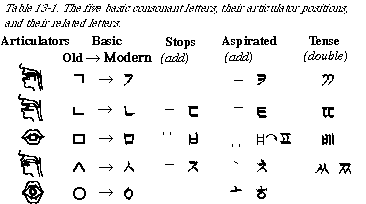Inconvenience is the mother of invention. The sheer complexity and inadequacy of using only Hancha to write the Korean language prompted a Korean king to create a novel and efficient phonetic script. This king was Sejong (13981450), the fourth in the Chosoen dynasty. His portrait is shown in Figure 13-1.
The king assigned a royal commission to provide a learned commentary on the Correct Sounds. The royal commission consisted of seven young scholars, all but one of whom were members of the Academy of Scholars, which was involved in research in many subject areas, including phonology. As part of their phonological research, the Korean scholars studied the languages and scripts of neighboring nations, such as Japanese, Mongolian, Manchurian, and Chinese. Through Buddhist texts some of them were likely to have been familiar with Indian phonetic scripts as well. The scholars' commentary, entitled the Explanations and Examples of the Correct Sounds,was published in 1446. It is composed of six sections: the shapes of the letters; initial sounds; medial sounds; final sounds; syllable blocks; and examples of letters in actual use. It concludes with a postface by the head of the commision, Choeng In-ji. One sentence from Choeng's postface is the second epigraph to this Part II.
Han'gul is first and foremost an alphabet, in which one letter codes one phoneme. But it is not like other well-known alphabets of the world, such as Roman and Cyrilic. As an alphabet Han'gul has the following five unique characteristics.

 Han'gul is an alphabet, as described so far, yet when it is written
its letters are not strung together in a line, as are the letters of the
English and other alphabets. A Han'gul letter, whether for a consonant or
a vowel, is always used in combination with other letters to form a block,
which may represent a CV, CVC, or CVCC syllable. For a syllable with no
initial consonant, such as a, the letter o with no sound value takes the place of the missing
consonant letter, thus ensuring that the syllable is constructed according
to the same pattern as a CV syllable, as shown in Table 13-3 (rows 1 and
5). An appropriate label for such a package of Han'gul alphabetic letters
seems to be "syllable block."
Han'gul is an alphabet, as described so far, yet when it is written
its letters are not strung together in a line, as are the letters of the
English and other alphabets. A Han'gul letter, whether for a consonant or
a vowel, is always used in combination with other letters to form a block,
which may represent a CV, CVC, or CVCC syllable. For a syllable with no
initial consonant, such as a, the letter o with no sound value takes the place of the missing
consonant letter, thus ensuring that the syllable is constructed according
to the same pattern as a CV syllable, as shown in Table 13-3 (rows 1 and
5). An appropriate label for such a package of Han'gul alphabetic letters
seems to be "syllable block."